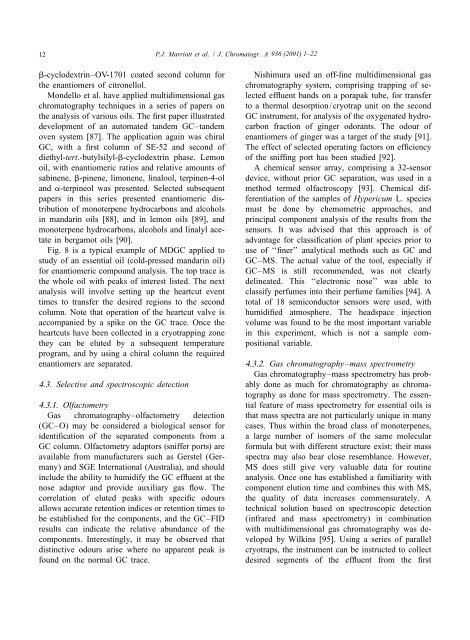Gas chromatographic technologies for the analysis of essential oils
Gas chromatographic technologies for the analysis of essential oils
Gas chromatographic technologies for the analysis of essential oils
You also want an ePaper? Increase the reach of your titles
YUMPU automatically turns print PDFs into web optimized ePapers that Google loves.
12 P.J. Marriott et al. / J. Chromatogr. A 936 (2001) 1–22<br />
b-cyclodextrin–OV-1701 coated second column <strong>for</strong> Nishimura used an <strong>of</strong>f-line multidimensional gas<br />
<strong>the</strong> enantiomers <strong>of</strong> citronellol.<br />
chromatography system, comprising trapping <strong>of</strong> se-<br />
Mondello et al. have applied multidimensional gas lected effluent bands on a porapak tube, <strong>for</strong> transfer<br />
chromatography techniques in a series <strong>of</strong> papers on to a <strong>the</strong>rmal desorption/cryotrap unit on <strong>the</strong> second<br />
<strong>the</strong> <strong>analysis</strong> <strong>of</strong> various <strong>oils</strong>. The first paper illustrated GC instrument, <strong>for</strong> <strong>analysis</strong> <strong>of</strong> <strong>the</strong> oxygenated hydrodevelopment<br />
<strong>of</strong> an automated tandem GC–tandem carbon fraction <strong>of</strong> ginger odorants. The odour <strong>of</strong><br />
oven system [87]. The application again was chiral enantiomers <strong>of</strong> ginger was a target <strong>of</strong> <strong>the</strong> study [91].<br />
GC, with a first column <strong>of</strong> SE-52 and second <strong>of</strong> The effect <strong>of</strong> selected operating factors on efficiency<br />
diethyl-tert.-butylsilyl-b-cyclodextrin phase. Lemon <strong>of</strong> <strong>the</strong> sniffing port has been studied [92].<br />
oil, with enantiomeric ratios and relative amounts <strong>of</strong> A chemical sensor array, comprising a 32-sensor<br />
sabinene, b-pinene, limonene, linalool, terpinen-4-ol device, without prior GC separation, was used in a<br />
and a-terpineol was presented. Selected subsequent method termed olfactroscopy [93]. Chemical difpapers<br />
in this series presented enantiomeric dis- ferentiation <strong>of</strong> <strong>the</strong> samples <strong>of</strong> Hypericum L. species<br />
tribution <strong>of</strong> monoterpene hydrocarbons and alcohols must be done by chemometric approaches, and<br />
in mandarin <strong>oils</strong> [88], and in lemon <strong>oils</strong> [89], and principal component <strong>analysis</strong> <strong>of</strong> <strong>the</strong> results from <strong>the</strong><br />
monoterpene hydrocarbons, alcohols and linalyl ace- sensors. It was advised that this approach is <strong>of</strong><br />
tate in bergamot <strong>oils</strong> [90].<br />
advantage <strong>for</strong> classification <strong>of</strong> plant species prior to<br />
Fig. 8 is a typical example <strong>of</strong> MDGC applied to use <strong>of</strong> ‘‘finer’’ analytical methods such as GC and<br />
study <strong>of</strong> an <strong>essential</strong> oil (cold-pressed mandarin oil) GC–MS. The actual value <strong>of</strong> <strong>the</strong> tool, especially if<br />
<strong>for</strong> enantiomeric compound <strong>analysis</strong>. The top trace is GC–MS is still recommended, was not clearly<br />
<strong>the</strong> whole oil with peaks <strong>of</strong> interest listed. The next delineated. This ‘‘electronic nose’’ was able to<br />
<strong>analysis</strong> will involve setting up <strong>the</strong> heartcut event classify perfumes into <strong>the</strong>ir perfume families [94]. A<br />
times to transfer <strong>the</strong> desired regions to <strong>the</strong> second total <strong>of</strong> 18 semiconductor sensors were used, with<br />
column. Note that operation <strong>of</strong> <strong>the</strong> heartcut valve is humidified atmosphere. The headspace injection<br />
accompanied by a spike on <strong>the</strong> GC trace. Once <strong>the</strong> volume was found to be <strong>the</strong> most important variable<br />
heartcuts have been collected in a cryotrapping zone in this experiment, which is not a sample com<strong>the</strong>y<br />
can be eluted by a subsequent temperature positional variable.<br />
program, and by using a chiral column <strong>the</strong> required<br />
enantiomers are separated.<br />
4.3.2. <strong>Gas</strong> chromatography–mass spectrometry<br />
<strong>Gas</strong> chromatography–mass spectrometry has prob-<br />
4.3. Selective and spectroscopic detection ably done as much <strong>for</strong> chromatography as chromatography<br />
as done <strong>for</strong> mass spectrometry. The essen-<br />
4.3.1. Olfactometry tial feature <strong>of</strong> mass spectrometry <strong>for</strong> <strong>essential</strong> <strong>oils</strong> is<br />
<strong>Gas</strong> chromatography–olfactometry detection that mass spectra are not particularly unique in many<br />
cases. Thus within <strong>the</strong> broad class <strong>of</strong> monoterpenes,<br />
a large number <strong>of</strong> isomers <strong>of</strong> <strong>the</strong> same molecular<br />
<strong>for</strong>mula but with different structure exist; <strong>the</strong>ir mass<br />
spectra may also bear close resemblance. However,<br />
MS does still give very valuable data <strong>for</strong> routine<br />
<strong>analysis</strong>. Once one has established a familiarity with<br />
component elution time and combines this with MS,<br />
<strong>the</strong> quality <strong>of</strong> data increases commensurately. A<br />
technical solution based on spectroscopic detection<br />
(infrared and mass spectrometry) in combination<br />
with multidimensional gas chromatography was de-<br />
veloped by Wilkins [95]. Using a series <strong>of</strong> parallel<br />
cryotraps, <strong>the</strong> instrument can be instructed to collect<br />
desired segments <strong>of</strong> <strong>the</strong> effluent from <strong>the</strong> first<br />
(GC–O) may be considered a biological sensor <strong>for</strong><br />
identification <strong>of</strong> <strong>the</strong> separated components from a<br />
GC column. Olfactometry adaptors (sniffer ports) are<br />
available from manufacturers such as Gerstel (Germany)<br />
and SGE International (Australia), and should<br />
include <strong>the</strong> ability to humidify <strong>the</strong> GC effluent at <strong>the</strong><br />
nose adaptor and provide auxiliary gas flow. The<br />
correlation <strong>of</strong> eluted peaks with specific odours<br />
allows accurate retention indices or retention times to<br />
be established <strong>for</strong> <strong>the</strong> components, and <strong>the</strong> GC–FID<br />
results can indicate <strong>the</strong> relative abundance <strong>of</strong> <strong>the</strong><br />
components. Interestingly, it may be observed that<br />
distinctive odours arise where no apparent peak is<br />
found on <strong>the</strong> normal GC trace.











![Bericht von Schimmel & Co. [Inhaber Gebr. Fritzsche] in Leipzig](https://img.yumpu.com/24438150/1/171x260/bericht-von-schimmel-co-inhaber-gebr-fritzsche-in-leipzig.jpg?quality=85)




